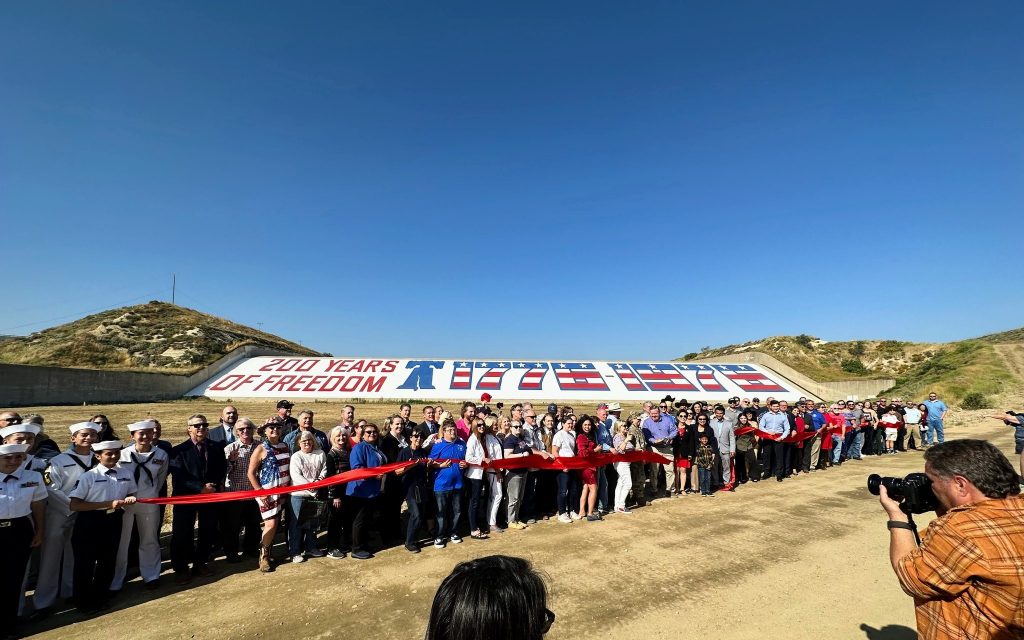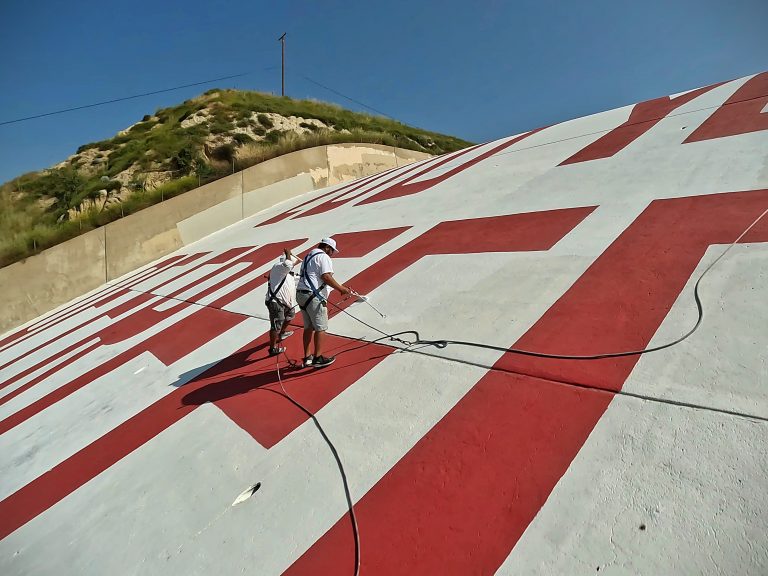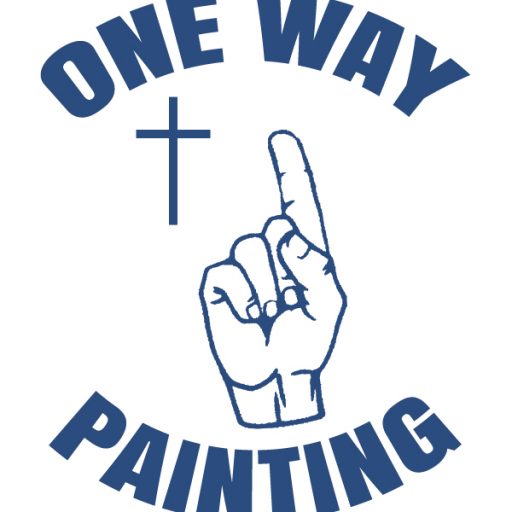The Complete History of the Prado Dam Mural
In the heart of Southern California lies a time-honored treasure: the Prado Dam Mural. Nestled in Corona, near the 71-91 interchange, this mural is more than a work of art. It’s a true testament to what can be accomplished when people come together for a common cause. Born from the vision of 30 high school students and supported by locals, the history of the Prado Dam Mural tells a tale of community, resilience, and the power we hold when we stand united.
And now after years of weathering and decay, the people have come together once again to save this iconic landmark in 2023. Join us as we explore the rich history of the Prado Dam Mural, from its inception, through its years of decay, and its triumphant restoration.
History of the Prado Dam Mural: 1976 Origins
The history of the Prado Dam Mural began in the Bicentennial year of 1976. As the U.S. approached its 200th birthday, the nation had accomplished a remarkable feat, paralleled by only a few democracies in history. However, despite this achievement, the country grappled with division while facing economic challenges and the aftermath of an unpopular war.
U.S. Bicentennial: Transforming the Heart of the Nation
Amidst this backdrop, a change in the Bicentennial Celebrations led to a remarkable transformation. Initially envisioned as a grand spectacle confined to a single city, the festivities took an exciting turn when small, decentralized committees across America took charge. Over 60,000 local events were organized across the country. The celebrations were grander, the fireworks more dazzling, and the sense of patriotism soared to new heights.
Dubbed the ‘4th of July on steroids’, the spirit of the Bicentennial swept through every corner of the nation. From parades to painted fire hydrants, everyone joined in the festivities, embracing a shared sense of patriotism.

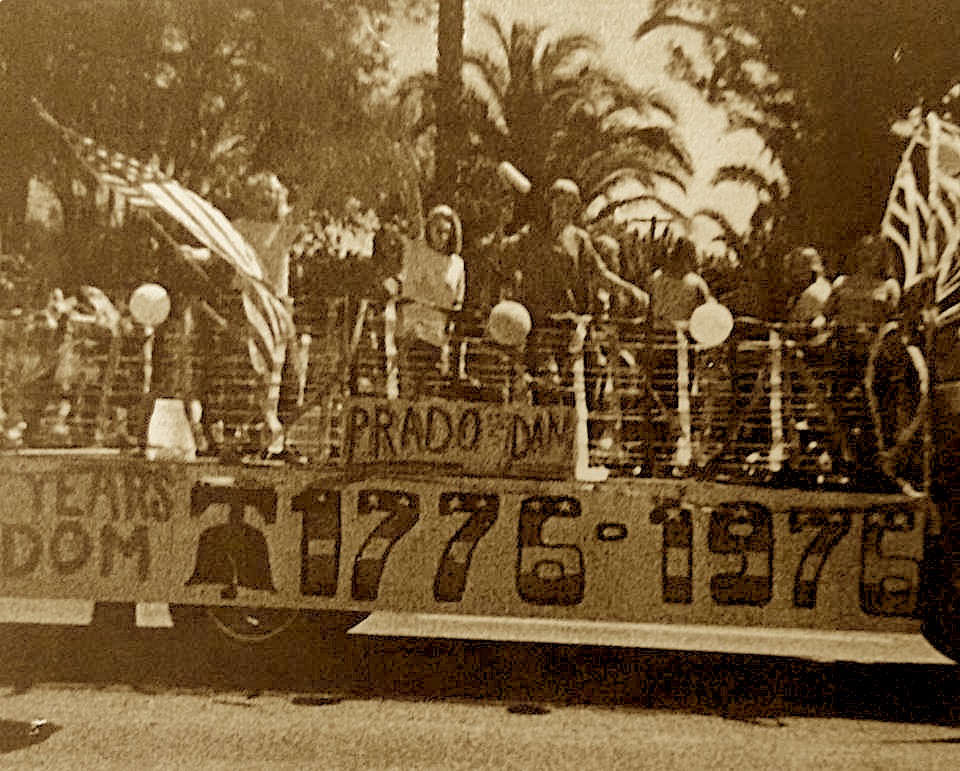
The all-inclusive event was an extraordinary volunteer movement, the largest in peacetime history. Individuals from all walks of life were all invited to share their stories, embodying the essence of the celebrations—a celebration of the people by the people. The ethos of ‘do your own thing’ permeated, inviting people across the nation to celebrate in their own authentic styles.
Students Envision a Monumental Mural at Prado Dam
Amid this nationwide fervour, Riverside County emerged as a shining example of the Bicentennial era when they embraced an extraordinary and inspiring idea spearheaded by Corona high student, Terri Smith. Terri envisioned a monumental mural for the Prado Dam spillway in Corona, sparking the idea of holding a high school contest to find the mural’s design. Supported by beloved high school activities director, Dave DiPaolo, Terri’s vision took flight.
Designing A Masterpiece
The mural contest was an amazing success, resulting in a patriotic design crafted by talented students Ron Kammeyer and Perry Schaefer. Emerging as the winning design, their artwork not only resonated with the students but ended up captivating the entire region.
Designed to be seen from the freeway, the mural’s creators drew inspiration from the concept of a bumper sticker. Its unique artistic style captures the essence of a simpler time, evoking a sense of nostalgia and transporting us back to the Bicentennial year it commemorates.
“It’s a piece of community artwork that reflects a happier time, a simpler time. A time when kids could do this.”
Eric Bjorgum, Mural Conservancy of los angeles
The Meaning Behind the Prado Dam Mural
With every element thoughtfully crafted, the mural resonates with themes of unity, resilience, and joy. Its inclusive nature, transcending politics and omitting any specific faces, allows each individual to forge their unique connection to the concept of freedom. It holds different meanings for different people, yet it has the power to bring us all together.
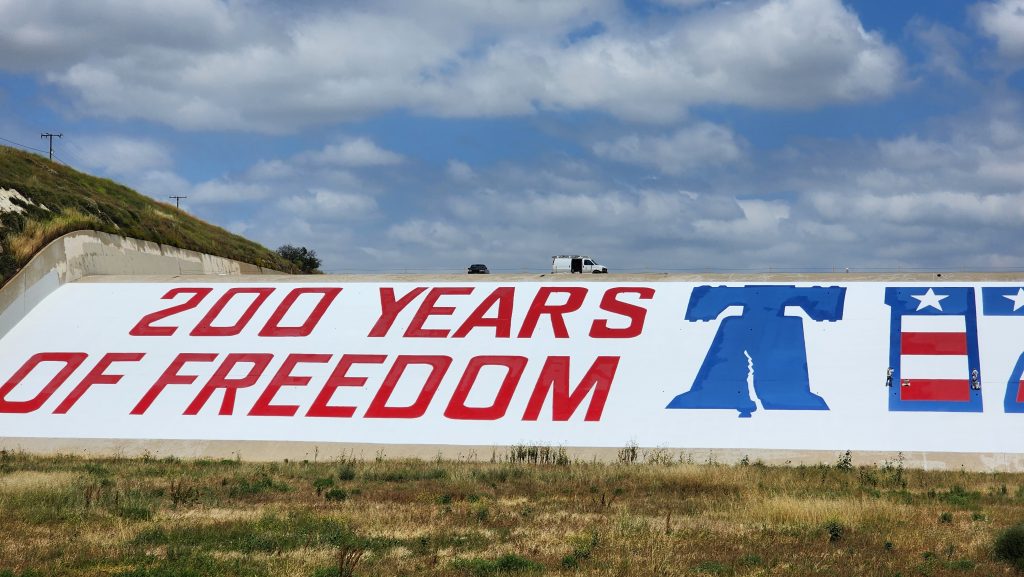
The bold red letters proclaiming ‘200 YEARS OF FREEDOM’ pay tribute to the unwavering determination of our nation’s founders and the indomitable strength of our veterans.
The depiction of the Liberty Bell evokes the unifying sound of church bells, serving as a powerful emblem of strength through unity. Its visible cracks not only remind us of our country’s imperfections but also symbolise our resilience in the face of challenges.
“Our country is not perfect, just like the Liberty Bell. We have maybe have a long way to go, but there’s a goal and there’s a symbol that we all want to work toward, and we’re all in this together.“
PERRY SCHAEFER, CO-DESIGNER
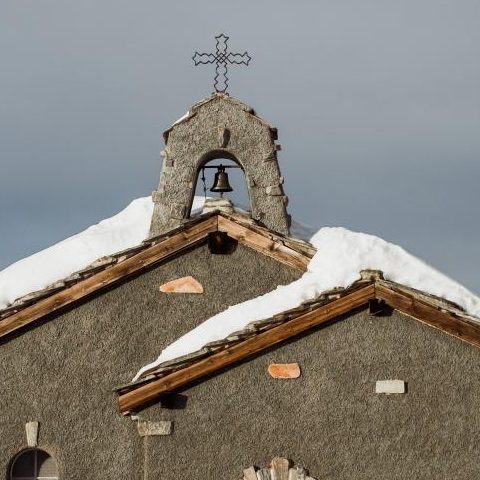
Lastly, the years 1776-1976 on the mural encapsulates our nation’s history. Representing moments of unity, freedom, and strength, these years hold profound significance in shaping our identity. From the birth of our independence in 1776 to the unifying Bicentennial Celebrations, these historical milestones reflect the journey of a resilient and united nation. Look closely, and you’ll find 13 stars within these years, paying homage to the original colonies and emphasising the incredible strength we possess when we stand united as one nation.
Painting the Vintage Mural
Once the design was decided, the next step was actually painting the mural. Terri was integral here too. Gathering a dedicated team of 30 student volunteers, they embarked on an extraordinary journey. It was a true community effort, with students, paint donors, and supportive moms all joining hands to make it happen. From the students volunteering their time, to local small businesses and hardware stores donating all the painting equipment, and the Army Corps of Engineers contributing the paint, everyone pitched in.
Together, they transformed an idea into a vibrant masterpiece, forever leaving a mark on Corona’s landscape. With 625 gallons of donated paint and a clear vision of what they wanted to represent, the students created a lasting tribute to America’s history and the spirit of its people.
Camping out at the dam over two weekends, they brought to life this colossal mural. Stretching 664 feet and standing 120 feet tall, the artwork was a must-see for locals and visitors alike.
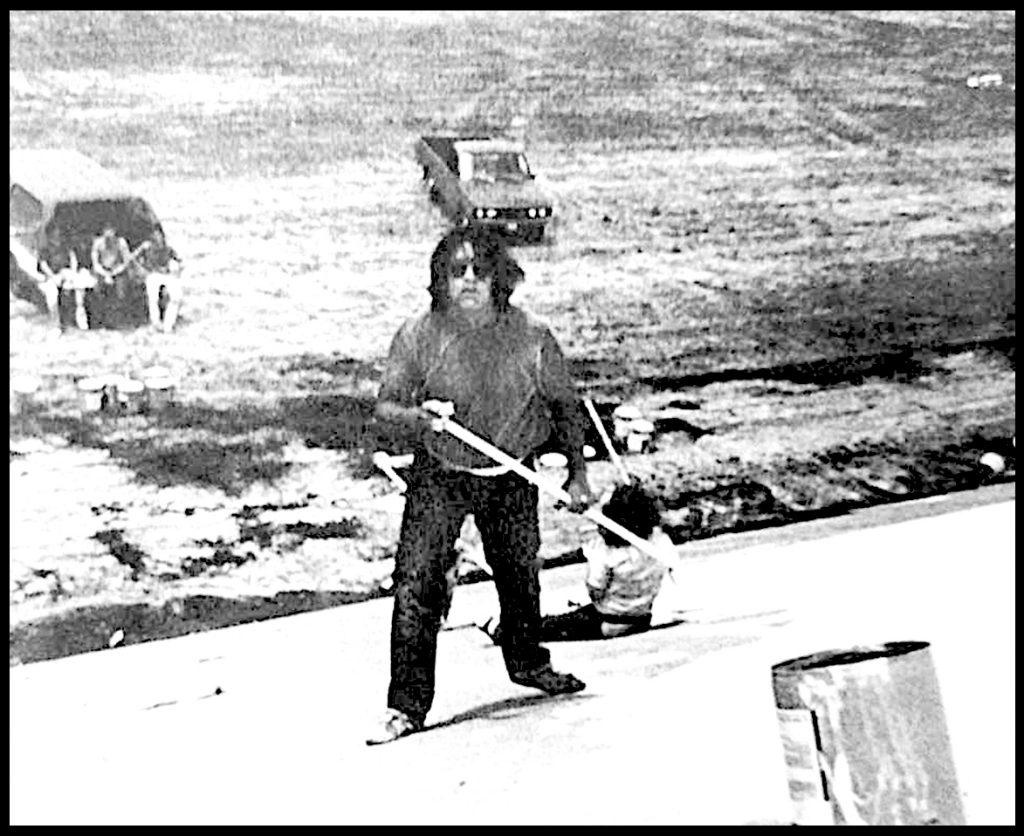
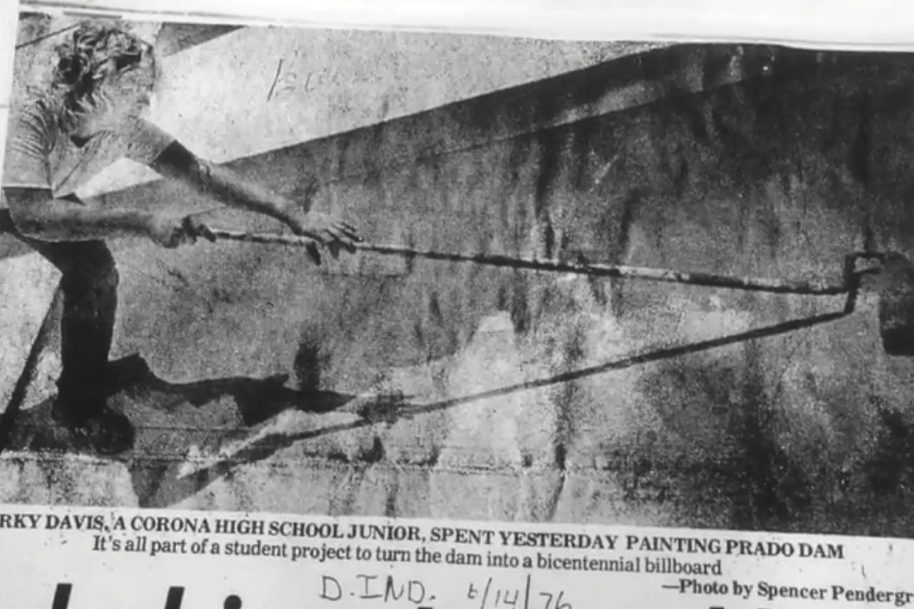

Mural’s Impact: A Unifying Source of Community Pride
The impact of the Prado Dam Mural was profound. With its prominent location visible to 300,000 drivers every day, it quickly became a source of pride. For many locals, it came to signify a sense of belonging and home. More than just artwork, it defined the region. Lying at the center of Chino Hills, Chino, Eastvale, Norco, and Corona, it was a central and unifying symbol for these five surrounding counties. It’s reach extends further, with the Prado Dam itself protecting Orange County residents from major flooding. In fact, the Orange County Water District owns over 2,000 acres behind Prado Dam.
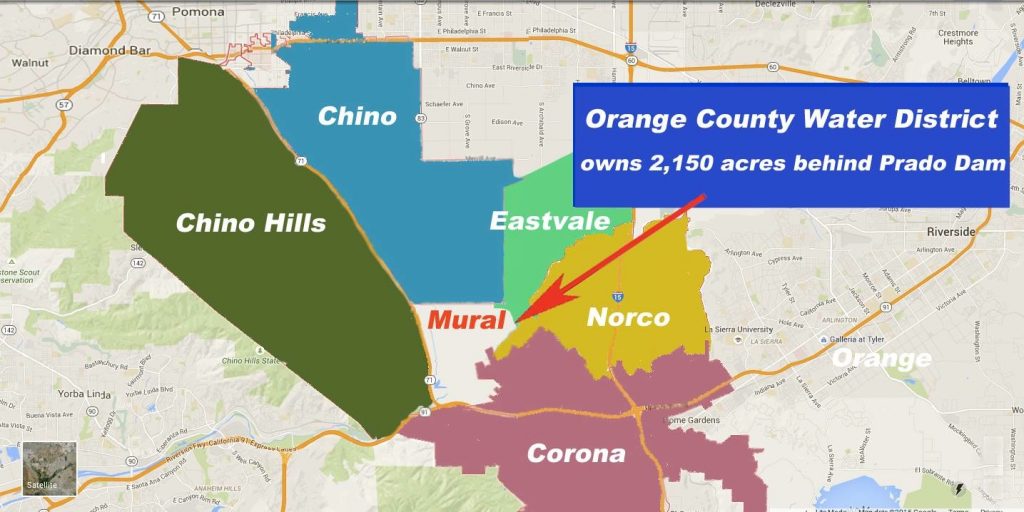
Beyond its significance at a local level, the Prado Dam Bicentennial Mural garnered attention on a national scale. Back in 1976, it was featured in a national educational ad about pollution. The message of unity and patriotism struck a chord with people across the nation. This national recognition further solidified its status as a beloved landmark with a remarkable history.
Fading Glory: The Mural’s Struggle Against Time and Neglect
As decades passed, the mural faced the ravages of time and neglect. Though individuals such as Jeff McCabe, proud owner of One Way Painting, and groups like the local boy scouts had repeatedly come forward to lend a hand for its upkeep, concerns over lead-based paint on the aging mural unfortunately meant their offers couldn’t be accepted.
By 2014, it had faded so much that its original design was barely recognizable. Its deterioration was a sore sight for local residents, tarnishing the legacy it once carried. For many, its decay was a somber reflection of the country, the region, and the very spirit of the people. This wasn’t just paint peeling away. It signified lost hope, a forgotten past, and a once vibrant symbol of community pride now in ruins.
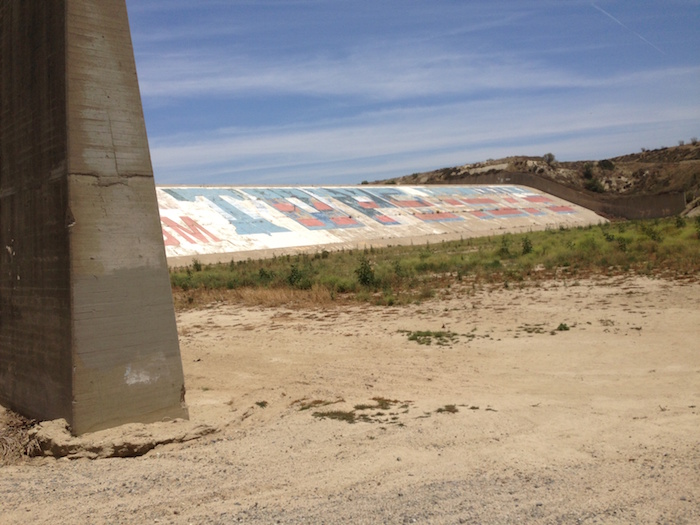
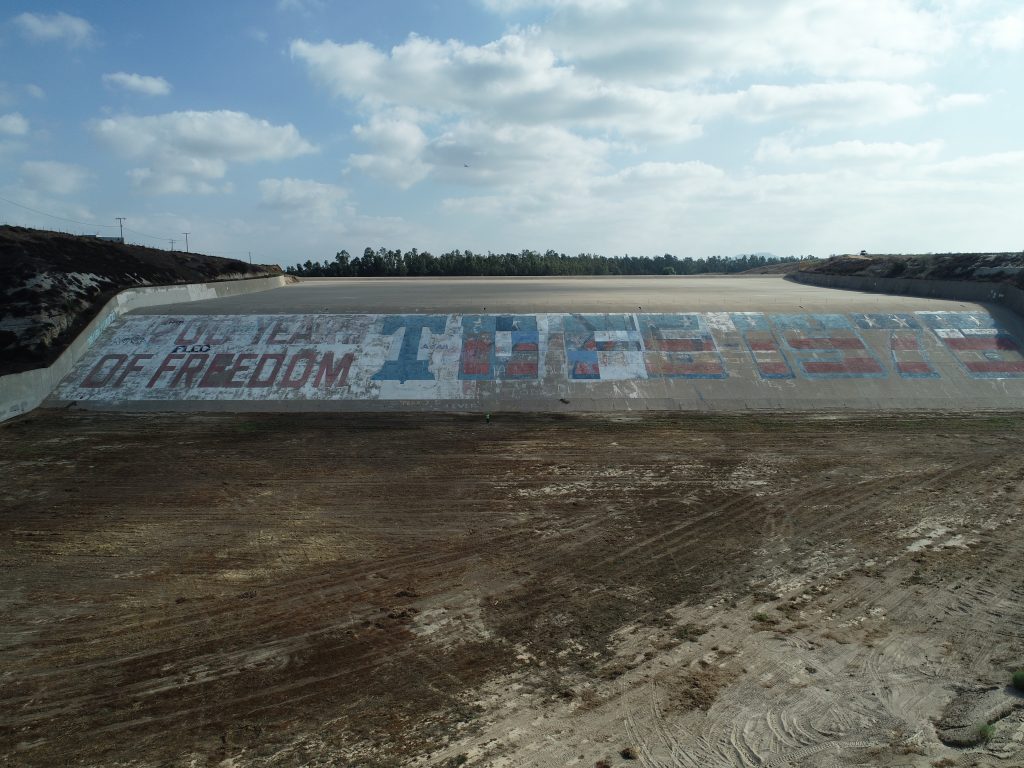
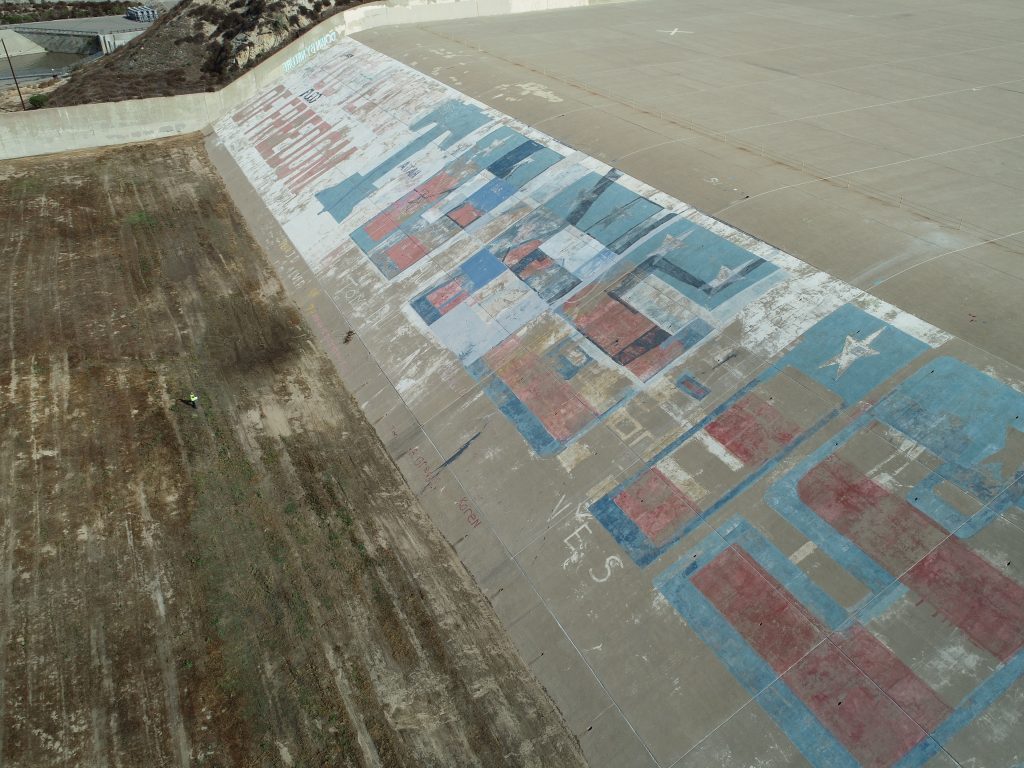
A Fallen Tribute
Being located in the Inland Empire, an area home to a vast community of veterans, the mural’s homage to freedom held deep significance. It stood as a poignant expression of gratitude and remembrance, honoring the sacrifices made to safeguard our liberties.
Witnessing the mural’s deterioration and defacement impacted many in the region who felt a profound connection to its sentiment. For Jim McCabe, both a veteran and a mural enthusiast, the sight of the mural’s decline was deeply saddening.
“It felt like the American flag was being stepped on”.
Jim McCabe – veteran, mural advocate and restoration supporter
Jim went on to paint a vivid picture of the mural’s significance. To him, and many others, the mural wasn’t just art. It was a bridge between memories of the past and hopes for the future. Its power lay in sparking conversations between the young and old, uniting generations and reminding us all to appreciate the sacrifices made for our freedoms.
The mural was their shared heritage. When its very existence was endangered, their collective love and admiration for it shone brighter than ever.
Mural’s Fate Hangs in the Balance
Controversy sparked in August 2014 when the Army Corps of Engineers (Corps) announced their intentions to remove the defaced mural from the spillway. Citing concerns over the mural’s lead-based paint, the mural was slated for removal within months. And despite the promise of a new mural at the dam, there were no guarantees for restoring the vintage artwork. But the community wasn’t ready to lose this beloved monument forever.
A Unified Front To Save The Mural
Fortunately, the damaged state of the mural didn’t deter the incredible solidarity that emerged to save it. Notably, the grassroots movement, Friends of the Prado Dam Mural, was formed. Springing into action, they created a petition to preserve the vintage mural. The response was amazing with the petition quickly gaining thousands of signatures. But they didn’t stop there. Determined to make their voices heard, they delivered the petition to representatives at the Corps as well as US Representative, Ken Calvert.
An Electric Night: Voices in Unity for the Mural
April 9, 2015, marked a defining day. In response to the mounting petition signatures, the Corps invited the community for a discussion to address the widespread concerns. The result? An overwhelming show of support.
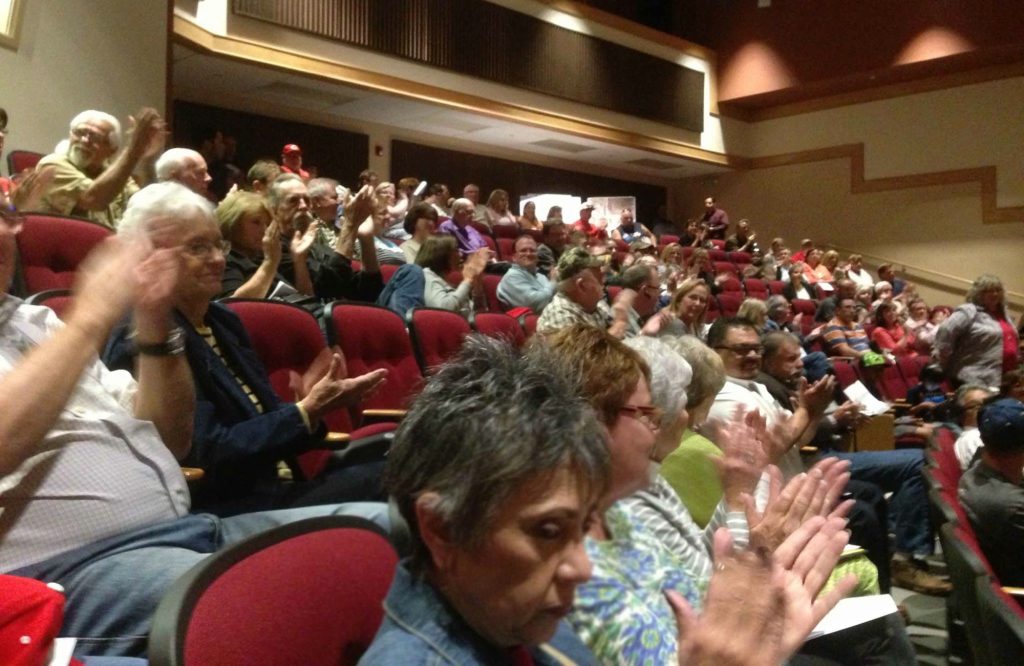
The turnout was astonishing, with the venue overflowing with over 350 mural enthusiasts, ranging from elected officials to the mural’s original artists. Over 50 people rose to speak, passionately advocating for the mural. The room resonated with applause and an unmistakable sense of hope.

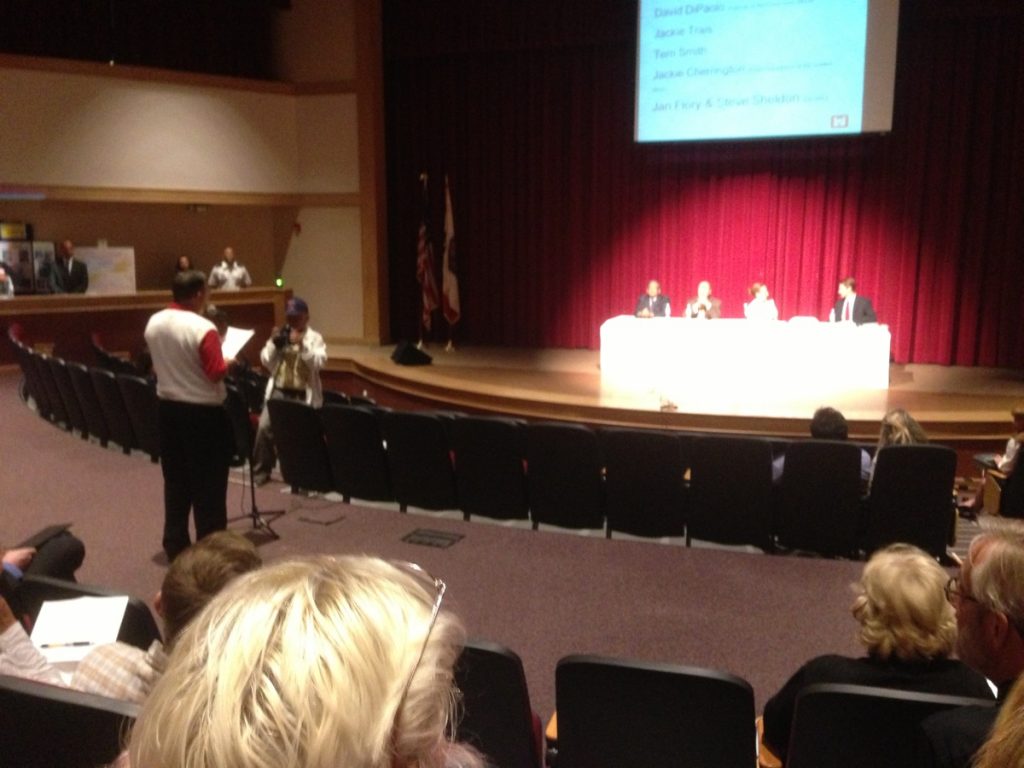
Yet, the victory was short-lived. Despite the passionate pleas, within 24 hours of the meeting, the Army Corps announced their intention to proceed with their plan to hold a contest for a new mural.
Five Counties Step Forward for One Mural
Even with the unsettling news, the people were not deterred. The petition to preserve the vintage mural continued gaining momentum. Moreover, all five surrounding counties passed resolutions in support of its restoration. Mayors, City Council Members, Directors, and even the Corona Norco Unified School District all expressed support. Talk about a united front!
From art historians to elected officials, veterans to local community members, the outpouring of support was truly overwhelming. Even the esteemed Mural Conservancy of Los Angeles, renowned for their expertise in preserving community artwork, was astounded by the unanimous backing for the restoration of the Bicentennial Mural.
We’ve been involved in many similar projects, but we’ve never seen this kind of unanimous support, from city, county, state, and federal government — not to mention the citizens, and especially veterans, to whom this mural is so important.
ERIC BJORGUM, mural conservancy of los angeles
Taking The Fight to Federal Court In 2015
While the mural’s significance was undeniable, the path to restoration was filled with challenges. As the mural faced the looming threat of removal, co-designer Ron Kammeyer took a decisive stand. He teamed up with the Mural Conservancy of Los Angeles, a renowned nonprofit organization dedicated to the preservation of LA’s precious artworks. With the support of attorney Eric Bjorgum, founder of the Conservancy, they brought their case to federal court.
Initial Legal Challenges
Determined to protect the mural, three consecutive lawsuits were filed, beginning in May 2015. In the first two lawsuits, Kammeyer’s primary legal objective was to assert his rights as an artist. By doing this, he worked to prevent any modifications to the mural he had co-created. However, the mural’s positioning on federal property and its association with flood control introduced complications.
A Turning Point in the Legal Battle
Despite unwavering determination, the outcomes of the first two lawsuits weren’t in favor of the mural, casting a shadow of uncertainty over its future. With two legal defeats, the mural’s destiny hung by a thread. However, the emergence of a third lawsuit breathed new life into the mission. This lawsuit was different from the first two, centering on the rich history of the Prado Dam Mural and its place in the community’s heart.
The Corps’ Historic Evaluation Under Scrutiny
The core contention of this third lawsuit was that the Corps hadn’t adequately done its due diligence in evaluating the mural’s status as a historic property. The core of this argument was the National Historic Preservation Act, which mandates a stringent review of a landmark’s historical value before any alteration or removal. Kammeyer asserted that the Corps had neglected this crucial procedure.
The Corps’ Defence
In rebuttal, the Corps anchored their defence in a 2011 historical assessment, which predominantly relied on a 1989 report. Their assertion? They’d done the necessary review and did make a good faith effort to determine the murals historic status.
Judge Finds Issues With Historic Assessment
But the judge found issues with their argument. Delving into the matter, the court discerned two significant flaws in the Corps’ dependence on the 1989 report:
- Incomplete Prior Evaluations: The 1989 report focused extensively on the historical significance of the Prado Dam itself. In contrast, it was astonishingly brief about the history of the Prado Dam Mural, bestowing just two sentences to it. This oversight necessitated a reevaluation due to “incomplete prior evaluations.”
- Age of Report. The second issue the judge found with the report was it’s age. Authored in 1989, the report had aged 27 years. Similarly, the mural had evolved considerably. While it was a mere 13 years old during the report’s inception, it had now matured to 40 years, possibly augmenting its cultural stature.
One Of The Last Artworks Associated With US Bicentennial
Of particular concern was the evaluations’ disregard for the mural’s possible change in its historic significance over time. Notably, the case brought to light that this mural is one of the last remaining artworks commemorating the Bicentennial.
[The mural is] one of the last public works of any kind associated with the US Bicentennial, and thus is a historic physical landmark.
Daniel Paul, Architectural historian
Other important factors mentioned in discussions on the mural’s potential cultural shift, included its:
- Recognition in several news publications as the largest patriotic mural in the U.S.
- Backing by numerous local, state, and federal government officials
- Impressive near 40,000 petition signatures in favor of preserving it.
In light of these findings, the judge was convinced its removal would not be in the public’s best interest.
A Last-Minute Judicial Reprieve Halts Mural’s Removal
Just when it seemed all hope was lost, mural supporters achieved a major victory. US District Court judge Jesus Bernal stepped in to protect the public interest. Just 24 hours before the mural’s scheduled removal on June 15, 2015, he issued a timely injunction. This injunction prohibited the Corps from altering or removing the mural until every legal issue was conclusively addressed.
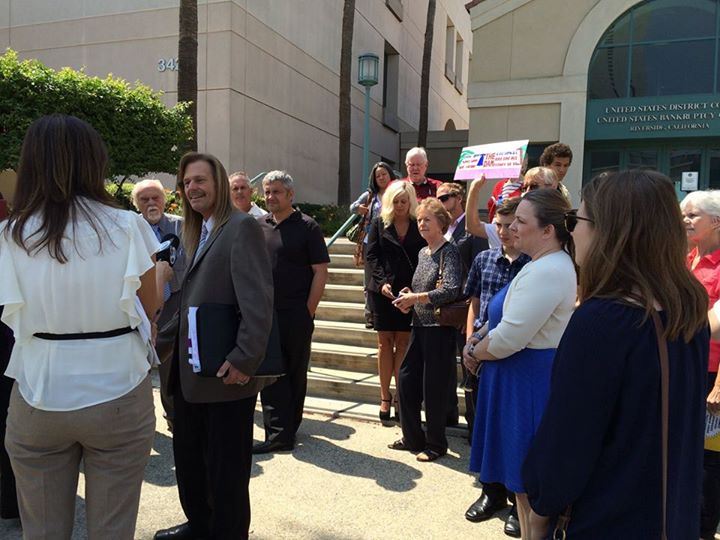
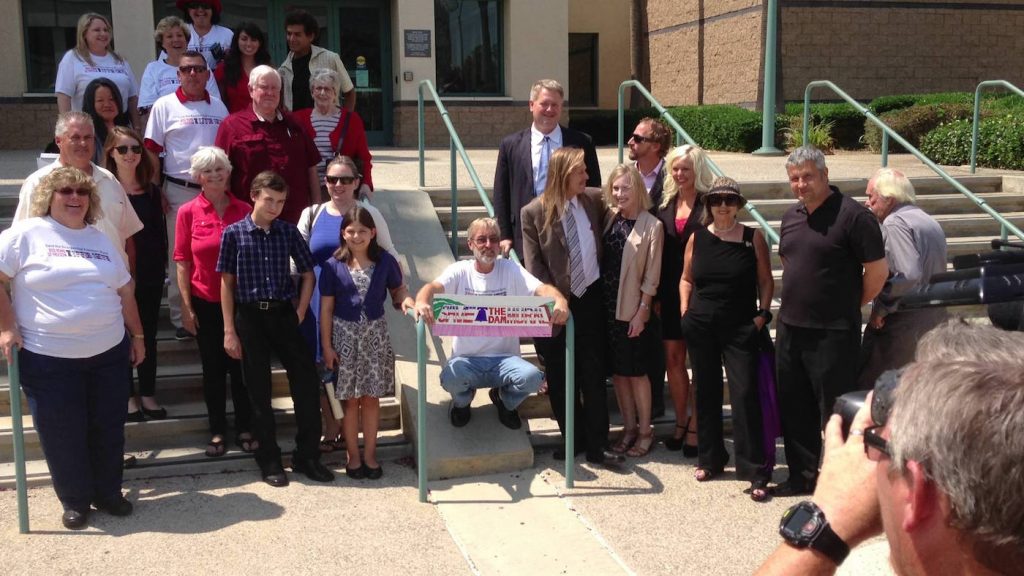
More than just halting the mural’s imminent removal, this lawsuit underscored the need to revisit the mural’s historic significance. It also shed light on the mural’s potential candidacy for the National Register of Historic Properties. Noting that the Corps had originally bypassed its full responsibility to evaluate the mural for such a recognition, they were mandated to reassess their findings. In the meantime, the mural was ordered to remain untouched.
The Fight For Historic Recognition
As a result of the lawsuit, the Corps embarked on a comprehensive evaluation of the mural in the subsequent years. This new assessment ventured into the modern significance of the mural, aiming to define its eligibility for historic listing. Crucially, unlike earlier evaluations, this assessment put the mural front and center.
The Corps, in fulfilling their responsibilities, met with a spectrum of key individuals integral to the mural’s history. This included interactions with the original painters of the mural and liaisons from nonprofit entities like Friends of the Prado Dam and the Bicentennial Freedom Mural Conservancy. Every facet was probed to generate an exhaustive report.
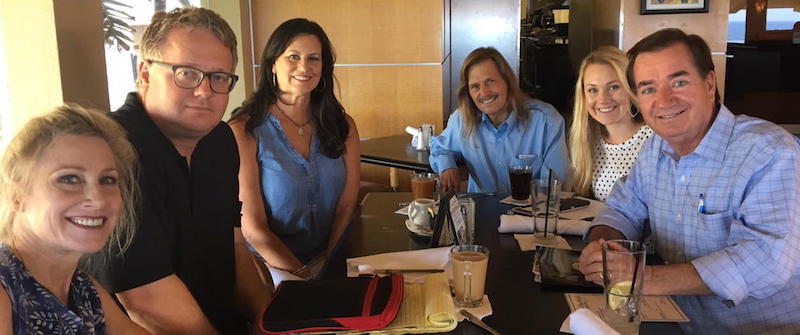
Denial of Historic Status
The Prado Dam Mural, with its vibrant history and cultural relevance, seemed destined for historic status. Yet, the path to such a designation was far from straightforward. Despite persistent efforts advocating for its importance in history, the Prado Dam Mural faced an uphill battle. The intricacies of this process and the eventual determination of the mural as lacking historic status can be accessed here. Meanwhile, let’s unpack the key factors that led to this decision.
The evaluation process was a collaborative effort involving several government entities. It commenced with the Corps assessing the mural’s historical value. Later, the California State Historic Preservation Office (SHPO) and the National Park Service also contributed their perspectives. Altogether, three significant hurdles emerged, casting shadows on the mural’s path to historical recognition.
Coming up short of the 50-Year Historic Milestone
In their May 2017 evaluation, the Corps pinpointed a primary concern: that it lacks exceptional significance under the National Register’s 50-year age guideline. Considering the mural was just slightly over 40 years old at the time of the report, the Corps felt it didn’t meet the threshold.
Significance Tied to a Single Event
Another issue was that the mural’s historic relevance seemed confined to commemorating the U.S. Bicentennial, not extending beyond it. The Corps questioned whether its scope and impact were broad enough to warrant historic listing.
Post this evaluation, the California State Historic Preservation Office redirected the Corps to expand the historical context, urging them to consider local Bicentennial festivities. This feedback prompted the Corps to dive deeper, researching for another year. Nevertheless, in May 2018, the Corps, once again, deemed the mural ineligible for the historic registry. Again, they consulted SHPO, which this time suggested seeking the verdict of the National Park Service.
Historic Fate Sealed by a Vandalized State
By February 2019, the evaluation baton was passed to the National Park Service. They had the final say on the mural’s fate. A decisive factor emerged: the mural’s current state took precedence over its potential post-restoration. Said differently, the evaluation placed a premium on the mural’s existing state, rather than its potential if restored. Vandalism was noted to have significantly diminished the mural’s original appeal and message.
The existing condition significantly obscures both the tangible artwork and the intended historic message.
National park service in 2019 evaluation of prado dam mural’s historic status
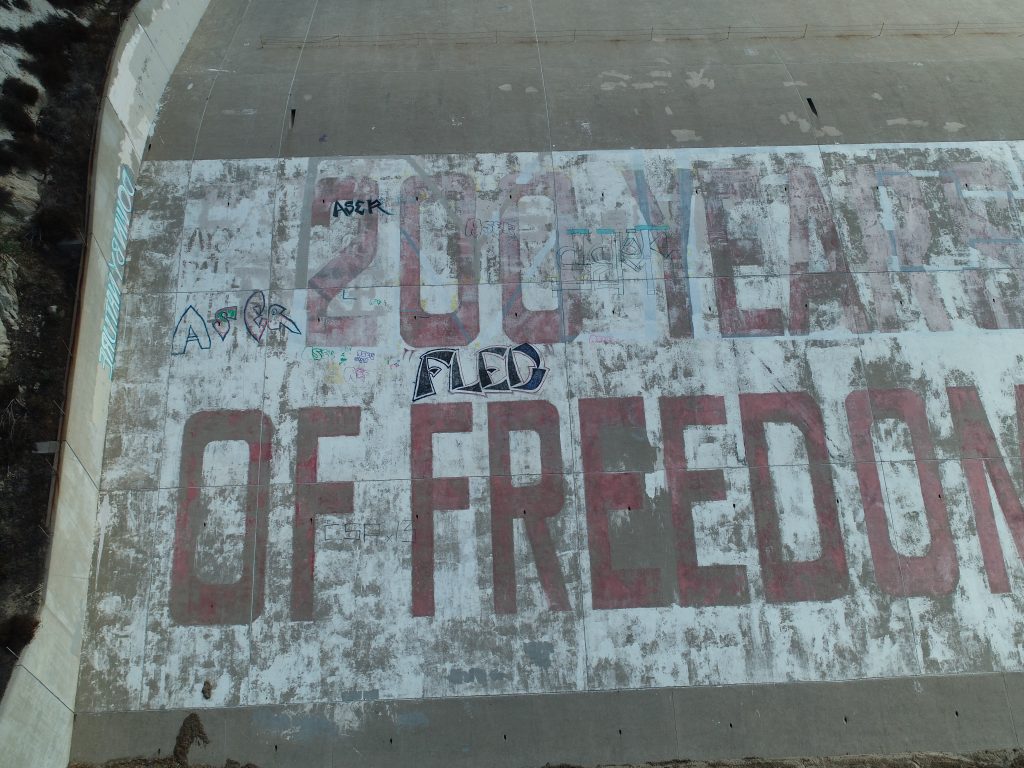
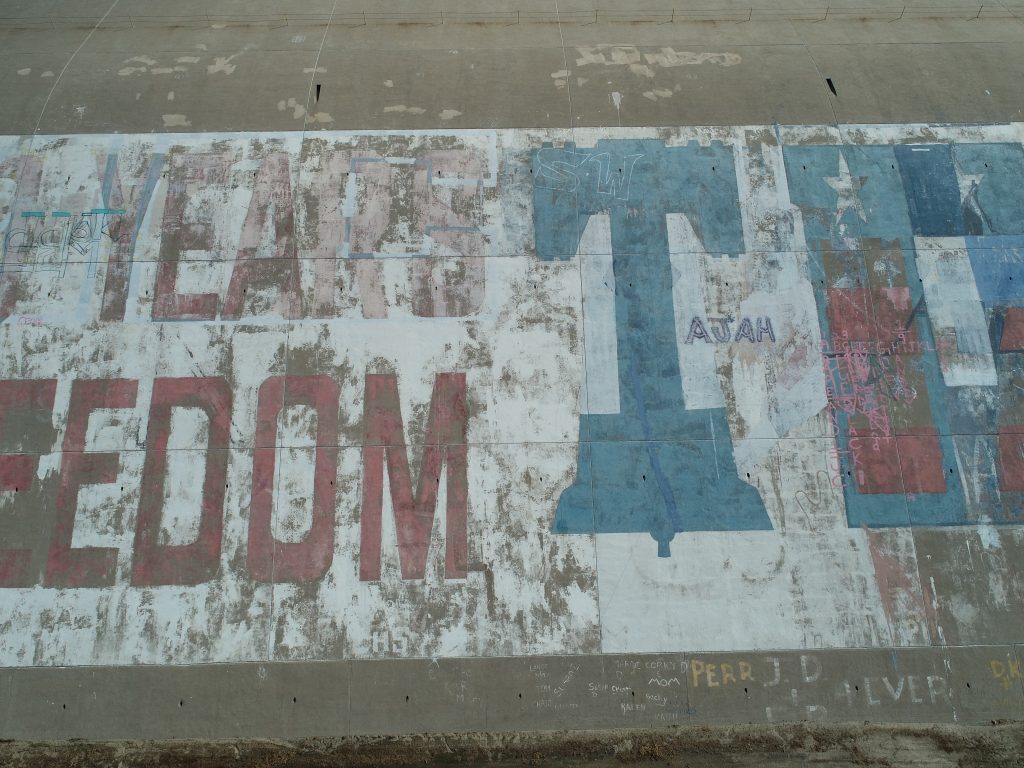
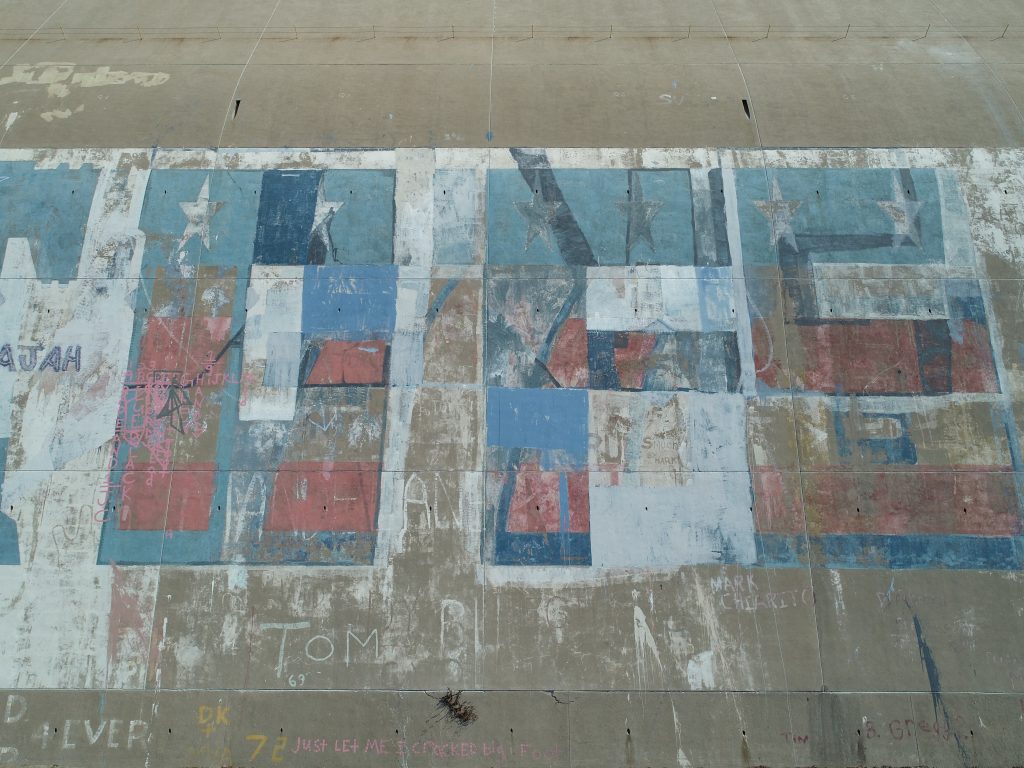
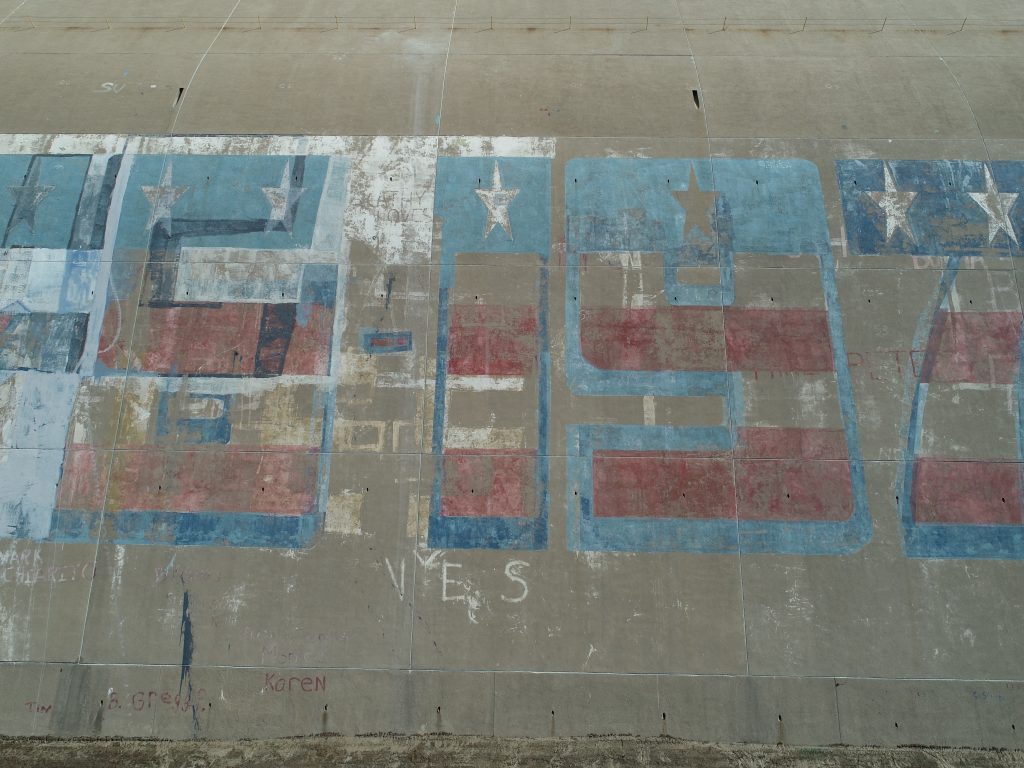
Temporary Injunction Lifted: A Potential Farewell
In 2019, with the National Park Service aligning with the Corps on the mural’s historic status, the legal shield that had temporarily protected the mural was lifted. This ruling left the mural vulnerable to removal by the Corps. Despite the setback, the court case became a driving force in the battle to save the mural.
Rallying around the mural’s significance, the Bicentennial Freedom Mural Conservancy emerged. Spearheaded by Jackie (Cherrington) Pierson and mural co-designer, Perry Schaefer, this organization became instrumental in mobilizing community support. These amazing volunteers went above and beyond to make the restoration a reality. Recognizing the importance of community involvement, they actively engaged with supporters on social media, attended public meetings, and even proudly marched in Corona’s 2019 4th of July Parade.
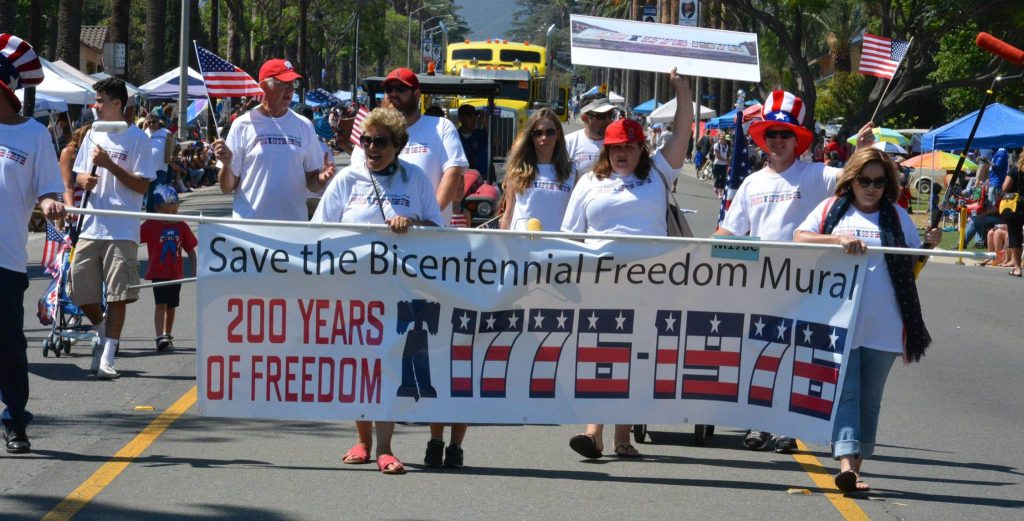
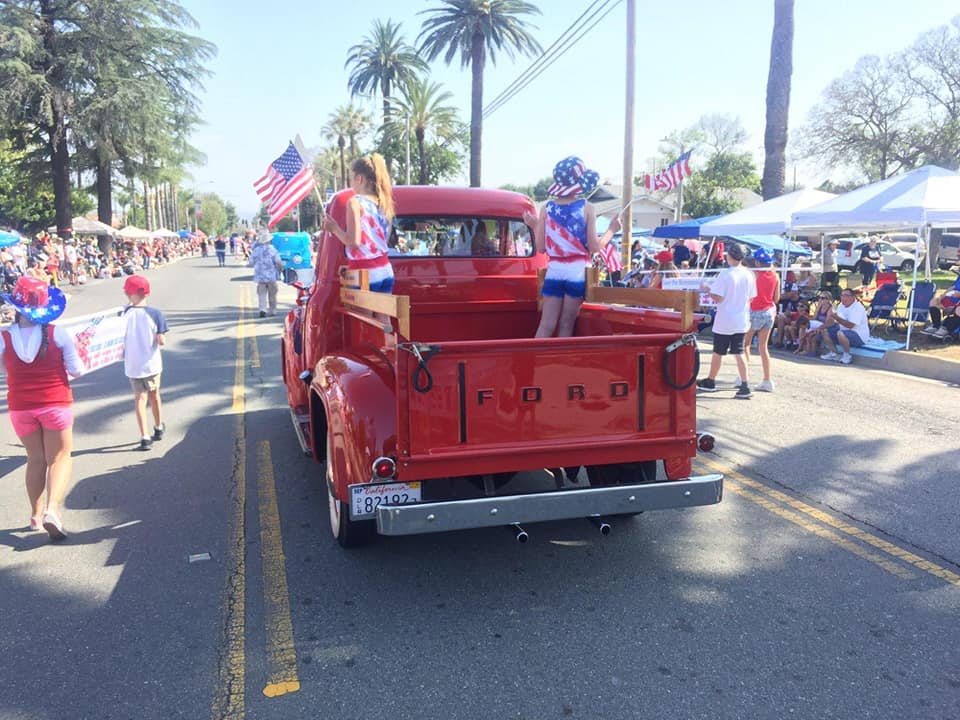
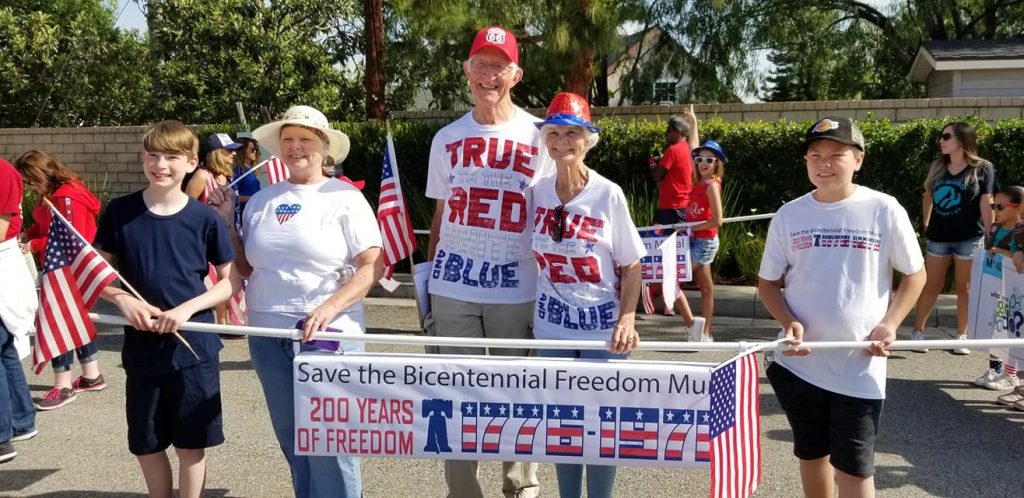
But they did much more than rally support, working tirelessly behind the scenes as well. Partnering with groups like Friends of the Prado Dam, they volunteered countless hours advocating for the mural’s restoration in negotiations with officials.
The Corps Offers an Olive Branch
At this point, the Corps legally had every right to proceed with the removal of the mural. With the Corps’ power to forever change the history of the Prado Dam Mural, the public’s concerns grew. However, in a striking twist of events, the Corps demonstrated an unexpected pivot, evoking a collective sigh of relief. While resolute in their stance on removing the vintage mural, they extended an olive branch of collaboration. Amidst the backdrop of the potential loss, hope emerged – the Corps expressed an openness to the prospect of restoration.
Mural Officially Green Lit for Restoration In Sep 2022
September 2022 marked a historic moment for the Prado Dam Mural, as the Corps officially announced that it was green lit for restoration. The Bicentennial Freedom Mural Conservancy secured approval from the Corps to repaint the mural.
This kind gesture, however, did not sweep away the challenges that awaited. Despite their endorsement, the path to revitalization was fraught with obstacles. Facing an overwhelming number of requirements, it was clear the carefree days of the 70’s had given way to a different era of regulations. The Conservancy had a long list of to-do’s. They had to raise all the funds for the restoration, contract a licensed painting company, secure the proper permits and meet all the Corps’ safety and insurance coverage requirements.
Navigating the Red Tape
Given the mural’s association with several governmental units, things quickly became complex.
Thankfully, Supervisor Karen Spiegel stepped in to assist. She guided Jackie and Perry at the Bicentennial Freedom Mural Conservancy, directing them to the necessary resources, permits, and departments. Her support played a crucial role in pushing the restoration project forward.
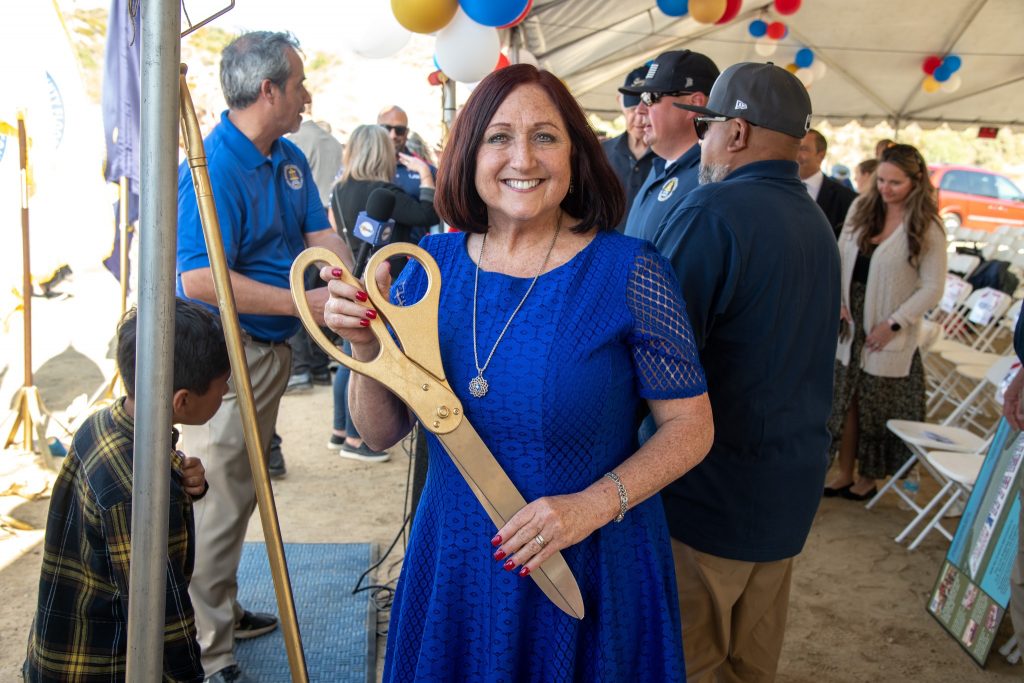
It’s worth noting that Karen Spiegel’s involvement is a continuation of her family’s long history with the Bicentennial Freedom Mural. In 1976, her mother-in-law, Mayor Flora Spiegel, championed the students’ painting of the Bicentennial Freedom Mural. And now, Karen Spiegel carries on that legacy by helping preserve the mural in 2023.
One Way Painting Team Visits The Vintage Prado Dam Mural
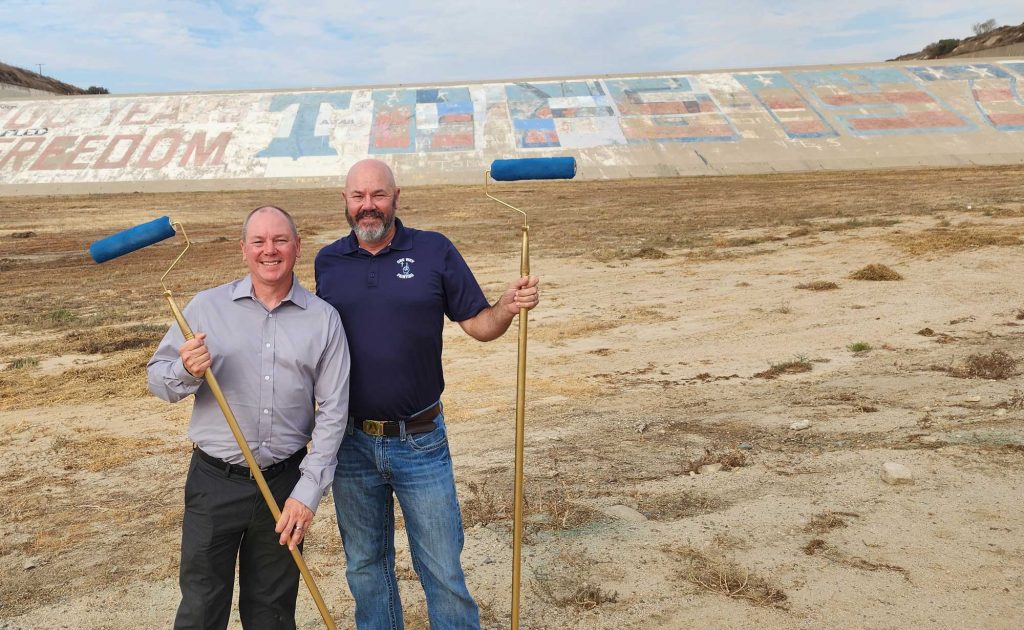
One Way Painting was contracted for the repainting of the mural. In September 2022, before the mural’s removal, we were granted the privilege of visiting the spillway. Over the course of two days, we carefully assessed and meticulously mapped the vintage artwork. This precise mapping served as our guide throughout the restoration process.
2022 Waves Goodbye To Vintage Mural
October 2022 saw the commencement of the mural’s removal. Facilitated by US Representative Ken Calvert’s efforts, Riverside garnered a $2.5 million federal fund to facilitate the mural’s safe removal considering its lead-based paint.
The process of removal required strict lead abatement which took months to complete. Between October 2022 and February 2023, the mural was carefully sandblasted away.

Community’s Generosity Fuels Restoration
So, how do you rally a community to save a mural? With heart, passion, and a sprinkle of nostalgia, that’s how! The Bicentennial Freedom Mural Conservancy brought that magic formula, launching a heartfelt fundraising campaign.
Everyone was invited to claim their own little piece of history on the mural, and boy, did they respond! The outpouring of love, shown through donations and the most touching letters. People eagerly vied for the opportunity to sponsor their desired letter, number or symbol on the mural.

Mirroring the spirit that brought the mural to life in 1976, individuals, businesses, and organizations rose to champion the mural’s cause. Notable companies like Dunn Edwards and Rust-Oleum stepped up, generously donating the entire 500 gallons of paint essential for the task. We at One Way Painting, we were deeply honored to provide all the labor for the restoration at cost. With the community’s incredible support, the Conservancy successfully raised the necessary $140,000 in no time at all. It was clear, with such overwhelming affection and commitment, the mural was destined to shine once again!
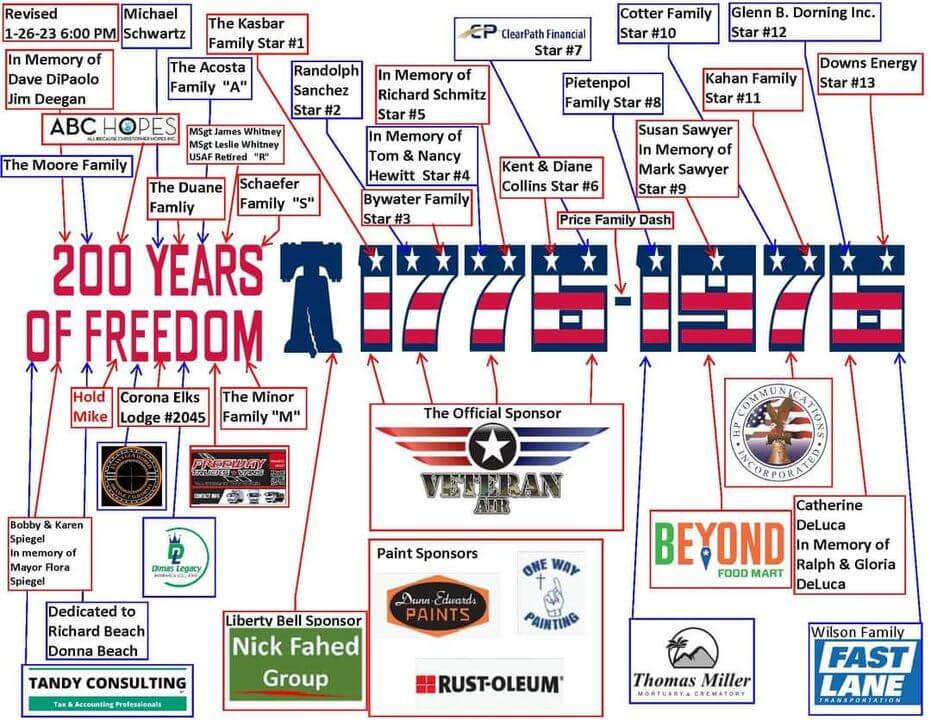
Restoring the Vintage Mural 24 Days
After more than a decade of obstacles, the moment finally arrived to reimagine the dam’s iconic artwork. Our team at One Way Painting felt deeply honored to be part of this journey. Collaborating with the Mural Conservancy of LA, we partnered with Riverside County to bring the vintage mural back to life.
With our comprehensive plan in hand, we delved into 24 days of dedicated work. This included the initial 2 days completed before the mural was removed and the subsequent 22 days that commenced on April 4th, 2023. The culmination of our efforts was marked by a joyful completion on May 9th, 2023.
And with that accomplishment under our belt, it officially marked us at One Way Painting as the best ‘dam’ painting company around! We invite you to read about our painting journey at Prado Dam. This article not only reflects our dedication, but also showcases the ‘One Way’ we do painting, providing homeowners with a glimpse of what they can expect when working with us.
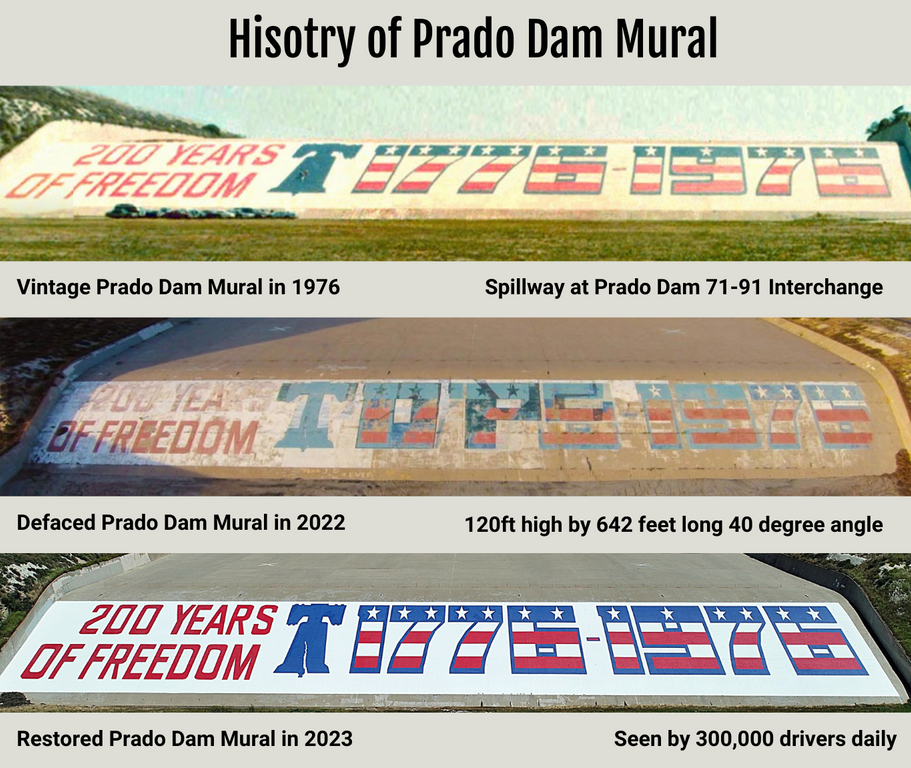
Ribbon Cutting Ceremony
We are incredibly grateful for the community’s support during the restoration of this mural. It truly belongs to all of us, and we wanted to make sure the community was involved every step of the way. That’s why we documented the entire process. On June 2, 2023, a moment of immense pride and joy arrived as dignitaries joined hands to ceremoniously unveil the final sections of the restored mural. This grand reveal marked a significant milestone in the mural’s journey and a triumphant celebration of its revival.
Partners Of The Prado Dam Bicentennial Mural
The restoration of the mural was a true community endeavor, and we are immensely thankful to everyone who played a role, large or small. For those seeking patriotic companies for shopping or just browsing local counties that were in support, we invite you to explore the amazing names that stood behind the restoration.
Writing the Story of the Prado Dam Mural Together
The story of the Prado Dam Mural is a captivating tale that continues to unfold with each passing day. Thanks to the incredible individuals who have united to preserve its remarkable legacy, the mural will continue to inspire generations to come. It’s a beautiful testament to the power of community and what can be achieved when we come together.
Celebrating July 4, 2023 at Prado Dam
The Bicentennial mural at Prado Dam knows how to throw a party, and boy, did it put on a show on the evening of July 4, 2023! Thanks to the Riverside County Water District, the dam lit up like never before, illuminating the newly restored mural in all its glory. It was truly a sight to behold! But if you happened to miss this incredible moment, don’t fret! Our resident drone maestro, Alan Sturm, worked his magic and captured some mind-blowing shots that will make you feel like you are there.
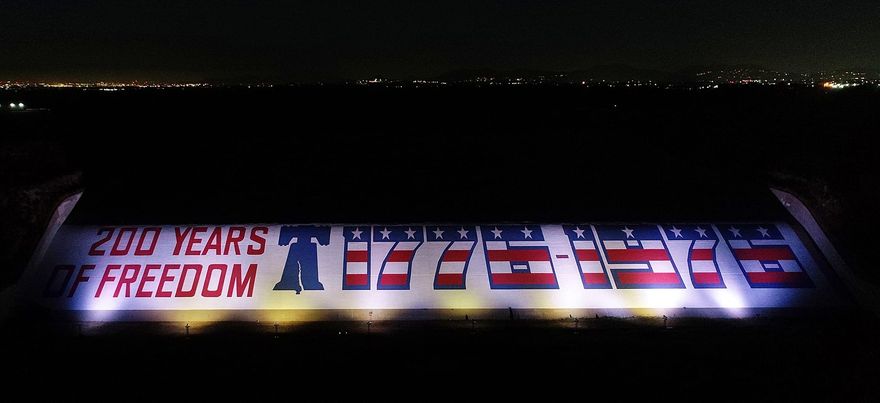

Preserving Legacy, Inspiring Generations
From its birth as a tribute to freedom in the bicentennial year to the battles for historic recognition and the remarkable efforts that led to its restoration, this mural has weathered storms both literal and metaphorical. Today, as the Prado Dam Mural stands once again in its vibrant glory, it carries with it the weight of history and the hopes of the future. Every drop of paint, every contribution made, and every moment of advocacy has contributed to this incredible tale.
The Prado Dam Mural serves as a reminder that history is not just a thing of the past—it’s a living, breathing narrative shaped by the hands and hearts of those who believe in its significance. So, as you gaze upon the mural, let it be a source of inspiration. In a world that often speeds forward, the Prado Dam Mural invites us to pause, reflect, and celebrate the present while honoring those who came before us and contributing to a better future. Thank you so much for joining us on this journey, we appreciate all of your support.
